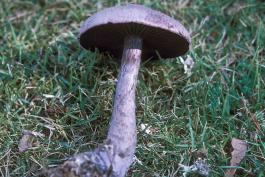
Dry, grayish violet cap, pale violet gills, a club-shaped stalk, and a cobwebby partial veil. Found in mixed woods, singly or in groups of many. August–October. Cap bell-shaped, with incurved margin; grayish violet; texture dry, silky; young specimens often have a fine, cobwebby veil that stretches from the margin to the stalk. Gills broad; spacing close; pale violet becoming rusty or cinnamon brown with age; gills attached to stalk. Stalk enlarging toward base; violet; texture fibrous, dry. Universal veil white, leaving a thin, sheathlike covering on the lower half of the stalk. Partial veil white and cobwebby. Spore print rust. Spores magnified are elliptical, brownish.
Lookalikes: Some other Cortinarius species, which are poisonous. The choice blewit (Lepista nuda) does not have a veil and the gills do not turn brown with age. The purple-gilled laccaria (Laccaria ochropurpurea) has white to pale violet spores and no veil.
Cap width: 1¼–3 inches; stalk length: 1½–3 inches; stalk width: ¼–½ inch.

Statewide.
Habitat and Conservation
Found in mixed woods, singly or in groups of many.
Status
It is not recommended for eating. This species could be confused with some poisonous Cortinarius species.
Life Cycle
This species is mycorrhizal: It exists most of the time as a network of cells (mycelium) connected to tree roots, in a symbiotic relationship with the tree. (Many trees fare poorly without their fungal partners.) When ready to reproduce, the mycelium develops the mushroom—this is the reproductive structure. Spores are produced in the gills and are released to begin new mycelia elsewhere. The mycelium of a mushroom can live for decades.
Human Connections
Sometimes this mushroom is called the "pearly webcap." All mushrooms in the genus Cortinarius have a cortina (a cobwebby veil) that goes from the cap margin to the stalk but may disappear with age. All "corts" have rusty brown spores that often leave the gills rusty brown.
Ecosystem Connections
This is one of many fungus species that help nourish forest trees through symbiosis. The netlike fibers of the fungus cover the surface of a tree’s roots, increasing the surface area and the roots’ ability to absorb water and nutrients. In return, the tree shares nutrients with the fungus.


Mushrooms are a lot like plants, but they lack chlorophyll and have to take nutrients from other materials. Mushrooms are neither plants nor animals. They are in a different kingdom — the fungi. Fungi include the familiar mushroom-forming species, plus the yeasts, molds, smuts, and rusts.
Always be cautious when eating edible mushrooms. Be absolutely sure of the ID, and only eat a small amount the first time you try it to avoid a reaction..





















